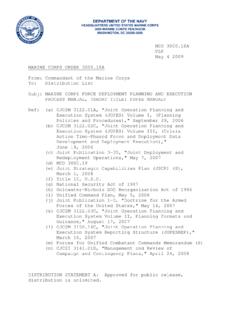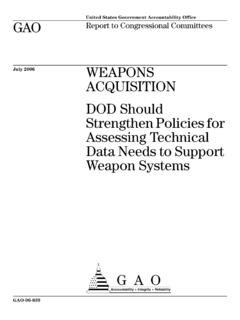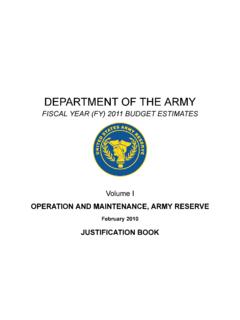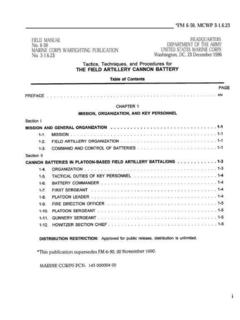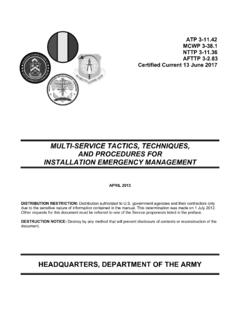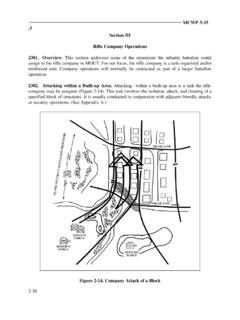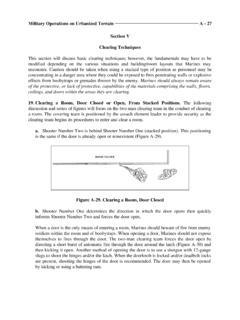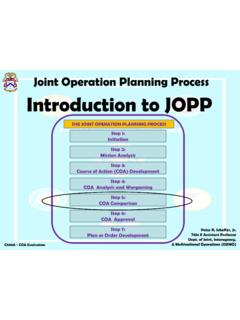Transcription of INTRODUCTION TO TACTICAL DIGITAL INFORMATION LINK J …
1 ARMY, MARINE CORPS, NAVY, AIR FORCE. TADIL J. INTRODUCTION TO. TACTICAL DIGITAL . INFORMATION LINK J. AND QUICK. REFERENCE GUIDE. FM mcwp 3-25C. NWP AFTTP(I) AIR LAND SEA JUNE 2000. APPLICATION. CENTER. DISTRIBUTION RESTRICTION: Approved for public release; distribution is unlimited. MULTISERVICE TACTICS, TECHNIQUES, AND PROCEDURES. FOREWORD. This publication has been prepared under our direction for use by our respective commands and other commands as appropriate. JOHN N. ABRAMS J. E. RHODES. General, USA Lieutenant General, USMC. Commander Commanding General Training and Doctrine Command Marine Corps Combat Development Command B. J. SMITH TIMOTHY A. KINNAN. Rear Admiral, USN Major General, USAF. Commander Commander Navy Warfare Development Command Headquarters Air Force Doctrine Center This publication is available on the General Dennis J. Reimer Training and Doctrine DIGITAL Library at PREFACE.
2 1. Scope This publication introduces TACTICAL DIGITAL INFORMATION Link (TADIL) J. It is a guide for warfighters who have limited or no experience or background in TADIL J and who need a quick orientation for supplemental or in-depth INFORMATION . The term TADIL J is used throughout the publication as United States (US) standard terminology, though TADIL J is known as Link 16 by the North Atlantic Treaty Organization (NATO). The document provides a description of each US TACTICAL data system (TDS) that currently implements TADIL J. TDS descriptions include command and control (C2). and noncommand and control systems (for example, fighter aircraft) and their nomenclatures, capabilities, and limitations. Planning and operations considerations, network design and requests, architecture examples, and other general operational INFORMATION are included. 2. Purpose This document applies to the operating forces of the US Army (USA), US Navy (USN), US Marine Corps (USMC), US Air Force (USAF), and anyone else desiring a basic understanding about TADIL J.
3 It is a US unilateral-only document but it includes NATO and US allied INFORMATION where appropriate. The INFORMATION in this publication has been extracted from multiple sources, including allied, joint, and Service directives, standing operating procedures and handbooks, and related defense contractor system reference documents. These references are listed in Appendix F and in the References section. This publication is intended primarily for use by warfighters at the TACTICAL /. execution (unit) level who need to be familiar with or operate in a TADIL J. environment. Preparation of this document was in a joint forum and INFORMATION contained has been coordinated with respective Service doctrine commands and centers. 3. Application This multiservice publication is approved for use by the USA, USMC, USN, and USAF. This publication provides unclassified guidance for TADIL J planning and operations and their roles in the multi-TADIL world; thus giving readers an understanding of TADIL J's impact on plans and operations.
4 It assists warfighters in locating TADIL J reference manuals and points of contact, which in turn maximizes combat effectiveness. 4. Implementation Plan a. Participating Service command offices of primary responsibility (OPRs) will review this publication, validate the INFORMATION , and, where appropriate, reference and incorporate it in Service manuals, regulations, and curricula as follows: Marine Corps: PCN 14400007000. i b. Army. The Army will incorporate the procedures in this publication in US Army training and doctrinal publications as directed by the Commander, US Army Training and Doctrine Command (TRADOC). Distribution is in accordance with DA Form 12-99-R. c. Marine Corps. The Marine Corps will incorporate the procedures in this publication in US Marine Corps training and doctrinal publications as directed by the Commanding General, US Marine Corps Combat Development Command.
5 Distribution is in accordance with MCPDS. d. Navy. The Navy will incorporate these procedures in US Navy training and doctrinal publications as directed by the Commander, Navy Warfare Development Command. Distribution is in accordance with MILSTRIP Desk Guide and NAVSOP Pub 409. e. Air Force. Air Force units will validate and incorporate appropriate procedures in accordance with applicable governing directives. Distribution is in accordance with AFI 33-360. 5. User INFORMATION a. The TRADOC-MCCDC-NWDC-Air Force Doctrine Center (AFDC) Air Land Sea Application Center (ALSA) developed this publication with the joint participation of the approving Service commands. ALSA will review and update this publication as necessary. b. This publication reflects current joint and Service doctrine, command and control organizations, facilities, personnel, responsibilities, and procedures.
6 Changes in Service protocol, appropriately reflected in joint and Service publications, will likewise be incorporated in revisions to this document. c. We encourage recommended changes for improving this publication. Key your comments to the specific page and paragraph and provide a rationale for each recommendation. Send comments and recommendations directly to . ii Army Commander US Army Training and Doctrine Command ATTN: ATDO-A. Fort Monroe VA 23651-5000. DSN 680-3153 COMM (757) 727-3153. Marine Corps Commanding General US Marine Corps Combat Development Command ATTN: C42. 3300 Russell Road Quantico VA 22134-5021. DSN 278-6234 COMM (703) 784-6234. Navy Navy Warfare Development Command ATTN: Code N5. 686 Cushing Road Newport RI 02841-1207. DSN 948-4201 COMM (401) 841-4201. Air Force Headquarters Air Force Doctrine Center ATTN: DJ. 216 Sweeney Boulevard, Suite 109.
7 Langley AFB VA 23665-2722. DSN 754-8091 COMM (757) 764-8091. E-mail Address: ALSA. ALSA Center ATTN: Director 114 Andrews Street Langley AFB VA 23665-2785. DSN 575-0902 COMM (757) 225-0902. E-mail: iii FM mcwp 3-25C. NWP AFTTP(I) FM US Army Training and Doctrine Command Fort Monroe, Virginia mcwp 3-25C Marine Corps Combat Development Command Quantico, Virginia NWP Navy Warfare Development Command Newport, Rhode Island AFTTP(I) Air Force Doctrine Center Maxwell Air Force Base, Alabama 30 June 2000. TADIL J. INTRODUCTION to TACTICAL DIGITAL INFORMATION Link J. and Quick Reference Guide TABLE OF CONTENTS. Page EXECUTIVE SUMMARY .. vii CHAPTER I SYSTEM OVERVIEW. Description .. I-1. Communications .. I-2. Employment .. I-6. Data Link Advantages .. I-8. CHAPTER II ARCHITECTURE. Network Design .. II-1. Parameters .. II-1. Network Completion .. II-1. Pulse Deconfliction.
8 II-1. Frequency Assignments .. II-3. Architecture Examples .. II-3. CHAPTER III OPERATIONS. Multilink III-1. Joint Service Operations .. III-6. iv Battle Group Surveillance .. III-8. Battle Group Air Control .. III-9. Joint Interface Control .. III-10. Operating Considerations .. III-11. Link Troubleshooting Considerations .. III-11. APPENDIX A SYSTEM CAPABILITIES AND LIMITATIONS .. A-1. APPENDIX B JTIDS CRYPTOGRAPHIC VARIABLE REQUIREMENTS .. B-1. APPENDIX C NETWORK DESIGN FACILITIES ..C-1. APPENDIX D ARMY TACTICAL DATA LINK-1 .. D-1. APPENDIX E NORTH ATLANTIC TREATY ORGANIZATION LINK-1 .. E-1. APPENDIX F QUICK REFERENCE GUIDE .. F-1. REFERENCES .. References-1. GLOSSARY .. Glossary-1. INDEX .. Index-1. FIGURES I-1 Network Participation Groups .. I-4. I-2 Stacked Nets .. I-6. I-3 TADIL J Message Catalog .. I-7. I-4 TADIL J Message Sets .. I-9. I-5 Track Identification.
9 I-10. I-6 Relative Navigation .. I-11. I-7 Geodetic Positioning .. I-11. II-1 Minimum Requirements for JTIDS/MIDS Frequency Assignment Request .. II-3. II-2 Navy Architecture Afloat .. II-4. II-3 Joint Architecture Afloat .. II-5. II-4 Combined Theater Architecture .. II-5. III-1 Data Forwarding Rules .. III-9. III-2 TADIL J Operating Considerations .. III-11. III-3 Troubleshooting Considerations .. III-12. B-1 SDU Employment ..B-2. v TABLES I-1 Stacked Nets .. I-5. III-1 USN Multilink Planning .. III-1. III-2 Model 4 Systems .. III-5. D-1 ATDL-1 Systems .. D-6. D-2 OPTASKLINK Message Entry Lists .. D-7. D-3 OPTASKLINK Message Sets .. D-7. E-1 NATO Link-1 Capabilities .. E-4. E-2 OPTASKLINK Message Entry Lists .. E-6. vi EXECUTIVE SUMMARY. TADIL J. INTRODUCTION to TACTICAL DIGITAL INFORMATION Link J. and Quick Reference Guide INTRODUCTION This publication provides multiservice procedures for TADIL J operations.
10 It includes: An overview of TADIL J basic terminology and operational considerations. System capabilities and limitations. Network design and network architecture examples. General guidelines for identifying common problems and situations. The functions of TADIL J in different types of operations. Overview The All Services Combat Identification Evaluation Team (ASCIET) final report for 1996 stated TADIL J/Link-16 Tactics, Techniques, and Procedures (TTPs) are immature. The Joint Requirements Oversight Council (JROC) tasked the Air, Land, and Sea Application (ALSA) Center to publish TADIL J multiservice TTPs to answer this deficiency. ALSA convened a working group of subject matter experts, 28 April to 1. May 1998, to analyze the requirements, research the material, and draft an initial product. As this is prepared, TADIL J fielding and system implementation is immature and incomplete.
